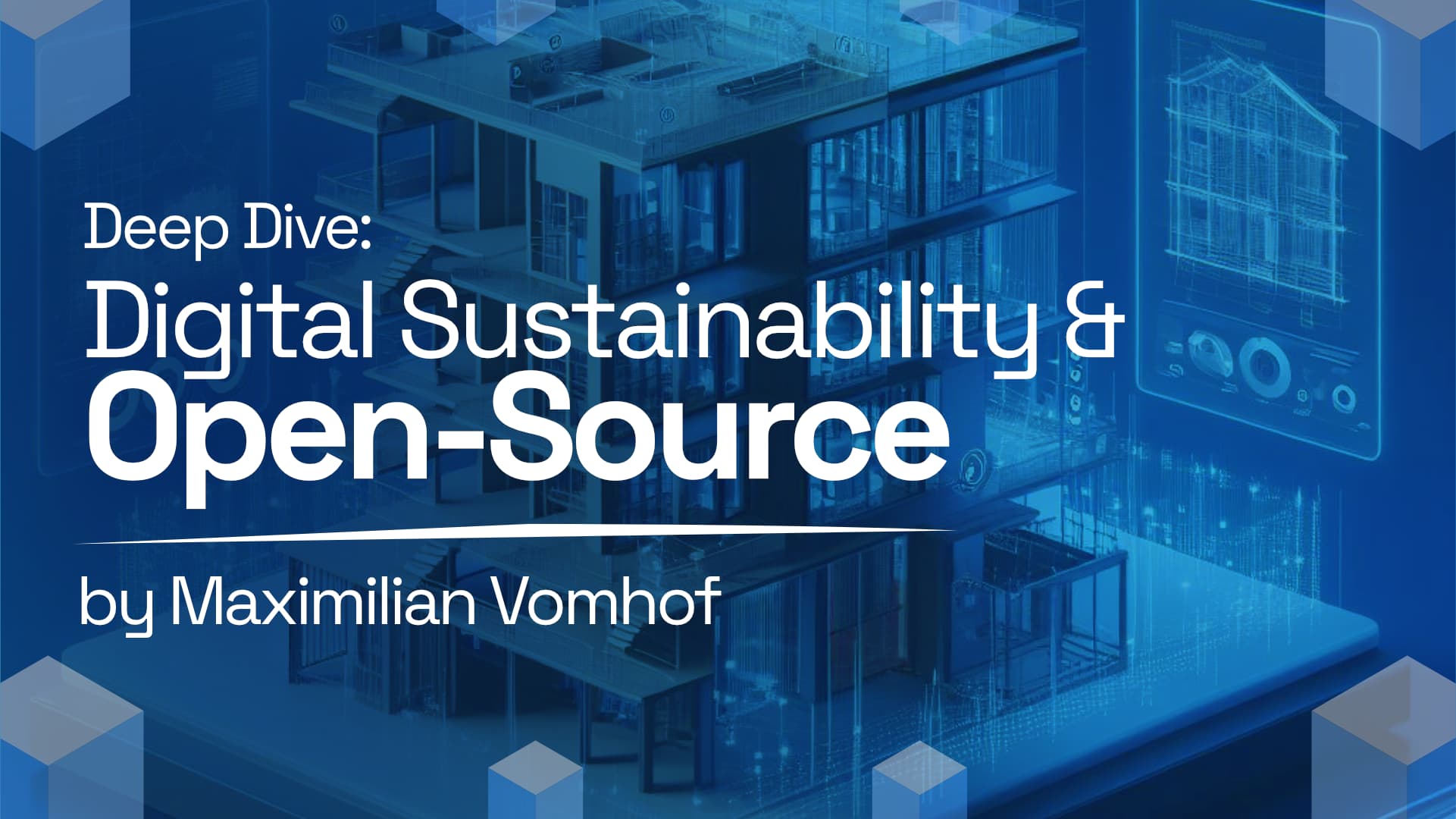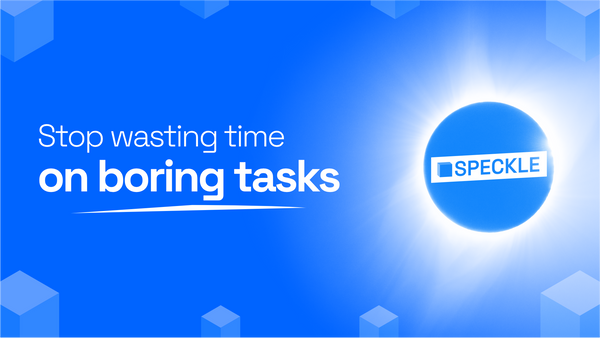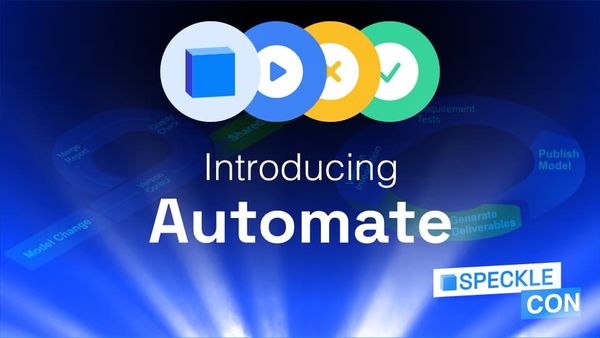This is part 8 of our SpeckleCon series. Here’s an overview of the series so far:
- Part 1: Breaking the Misconceptions of OSS
- Part 2: Innovating Beyond Zero-Sum
- Part 3: Rethinking the One Truth Fallacy
- Part 4: What Is Your Data Strategy?
- Part 5: Contributing to the OSS Ecosystem
- Part 6: The AI Infrastructure
- Part 7: Real Talk: The Balancing Act of Leading an Open Source Project
- Part 8: Digital sustainability <– this post
Abstract
We live in a world where change has become a constant - the buzzword "transformation" characterises the new reality. Familiar issues such as cost pressure in combination with increasing demands for resource efficiency, circular construction principles and a shortage of skilled workers present enterprises in the construction industry with fundamental challenges. It is undisputed that digitalisation can be an important support in this context. But here, too, change is the order of the day: new tools, new processes, always integration and training efforts. It is time to adapt appropriate strategies to deal with these circumstances.
The following article explores how implementing an open source approach can be a smart way for businesses to stay technologically up-to-date, even on a small budget.
Open source has changed collaboration in the software world
The open source model accelerates innovation by promoting collaboration and knowledge sharing. The core idea is: Technological infrastructure that is necessary for a company's value proposition, but is not a key differentiator, should not be developed from scratch over and over again. It makes more sense to build this infrastructure using open solutions and improving them rather than developing new ones (some examples from the software world are programming languages, database structures, CMS systems, encryption technologies and much more). After all, not only a few users from one company use a specific solution, but many users from many companies. They all have an interest in the open solution evolving and moving with the times - an unbeatable driver of innovation.

As a result, open source software enabled enormous leaps forward in the technology industry, changing and enriching our lives in many ways. Even the largest and most financially powerful technology companies in the world are taking advantage of open source software and freely accessible data sources.
Driven by this success, open source has become a movement and a way of working that goes beyond software production. The “open” movement uses the values and decentralised production model of open source software to find new ways to solve problems in different communities and industries.
The construction industry and its struggle with digitalisation
The construction industry is characterised by numerous small and medium-sized companies that operate locally with standard systems but individual processes. 90% of architecture and engineering offices have less than 10 employees, 62% of construction companies have less than 50 employees. Most companies have little to no budget for research and development - certainly not for the development of digital solutions. Broadly speaking, the industry has…
… a learning problem: Stakeholders find it difficult to adapt to new trends / technologies.
… an innovation problem: The landscape is characterised by closed ecosystems within companies and within software tools, which prevents innovation (and start-ups) from scaling.
… a collaboration problem: The “not invented here” syndrome is a real issue. In terms of digitalisation efforts, many companies still operate in competition rather than collaboration mode.
Challenges faced by individual organisations
Looking closer, all things related to digital solutions, purchasing decisions and data strategies do not have an easy standing in the industry. This is certainly related to the fact that most decision makers do not have a background in software engineering or similar. Also, overpromising on efficiency gains in the past causes hesitation. It is not surprising that it leads to frustration when the tools do not deliver what they promise. Especially when they are not developing along individual needs and become more expensive from year to year.
Another related issue is that it is difficult to attract tech talent. The traditional value creation process of most companies is not digital. Hiring and leading software engineers within these organisations is not an easy undertaking.
At the same time, all organisations are increasingly under pressure to a) participate in digital workflows with external partners, b) optimise their processes to stay competitive and c) commit to the grown expectations regarding transparency and sustainability from their clients.
Start-ups should be innovation boosters, but…
Start-ups are commonly seen as speed boats that can drive innovation faster and more agile than large companies. The problem with these speed boats is that they have no port to land in the construction industry – fragmentation, closed data silos and a lack of interfaces in established software tools make life difficult for software-oriented companies.
Although some examples show that it is possible to build a successful start-up in this industry, the majority of entrepreneurs struggle. A critical view on popular Prop- and ConTech maps can teach us a thing or two about the startup scene in the construction and real estate sector.
Firstly, the startup scene is less bustling than you would expect, given the market size. In addition, many startups are spin-offs from larger corporations and struggle to stand on their own feet. Hence, there is not so much movement on the innovation front. Many offerings are primarily digitising traditional, analogue processes without significant improvements. It is a bit like turning paper forms into PDFs without adding any interactive features. Also, many offerings are consulting and not product driven. These offerings are not SaaS products that can be used by the users themselves - often paid support from the start-ups is required or desired, which is a real burden to scale.
Last but not least another big burden can be identified: The only thing less efficient than a fully analog process is a “partially” digitised one. It is one of the reasons APIs became ubiquitous across much of the enterprise software world during the past decade. In the absence of APIs in the real estate and construction industry, data often has to be manually moved back and forth between legacy systems and the tools offered by start-ups – an effort that makes selling and scaling much more difficult for early stage start-ups.
Yes, open source can fuel the transformation of the construction industry
From a technical point of view, open source is a kind of licensing agreement that allows users to freely inspect, copy, modify and redistribute a software, and have full access to the underlying source code. Simply put, open source refers to software created by a developer who pledges to make the entire software source code available to users. On the other hand, proprietary or “closed source” software has source code that only the creator can legally copy, inspect, and modify. Top open source technologies celebrate the principle of open exchange, shared participation, transparency, and community-oriented development.
In general, the idea of decentralisation and especially the concept of continuous improvement with a small budget matches perfectly with the fragmented structure of the industry. The more open solutions and open interfaces developers can find, the easier it becomes for them to build robust value propositions that drive innovation and transformation with manageable resources.
Today, there are only a few sector-specific open source or open data projects. But there is momentum building up. It is fueled by projects like IfcOpenShell, BlenderBIM, Speckle, bldrs and ThatOpenCompany, to name just a few. This momentum is also supported by increasing efforts in the public sector to prefer open source solutions, aptly summarised with the hashtag #publicmoneypubliccode.
Let‘s have a look into five examples to illustrate common forms of interaction from organisations in the AECO industry with open source solutions:
- Using open source software tools free of charge
Yes, it exists: Free open software (FOSS) that provides professional tools and can be used free of charge. These tools are not marketed the same way like proprietary tools and you may not find the same support for technical issues. But, and that’s a big one, you can have a say in the development of the tools by financially supporting the developers behind the projects. Some examples with relevance for the Real Estate and Construction industry are BlenderBIM (CAD), FreeCAD (CAD), QGIS (geo information), GIMP (Image Editor), LibreOffice (office applications) and Mozilla Firefox (Browser). - Using open source code libraries free of charge
Next to a limited number of FOSS, you will find far more open source code libraries that are freely available. If you have the technical capabilities to implement open source code in your tech stack, you can do so without being charged (some restrictions are possible, depending on the licence chosen).
Example: Gaiup builds an LCA calculator. To exploit data in different CAD tools, they use Speckle’s toolbox, which is available open source. Gaiup’s engineers implement the tools and update them, whenever Speckle is releasing a new version that is relevant for them. Gaiup is in charge of maintaining their solution – it could even be the case that the Speckle team wouldn’t even know that Gaiup uses their tool. - Closing a service or a licence agreement with a provider of an open source solution
Charging for premium features around an open source core and offering services like updating systems or hosting the solution for a client is a very common business model for open source solutions. The difference to traditional licence models is that customers can often continue to use the software free of charge, even after their service contract has expired.
Example: OpenProject offers an open source project management tool. You can host it yourself for free for maximum security and control. Some organisations do appreciate additional support for installing and maintaining the solution, having access to premium features or simply having OpenProject host the solution for them. For these additional services, a fee is required just like with a proprietary SaaS tool. - Financing a feature in an existing project
Sometimes, an open source project lacks a feature that would be very relevant for you. Either you build the feature yourself and commit to the code repository or you commission the company behind the project to build it for you.
Example: vyzn uses the powerful library from compas to run a variety of geometric calculations within their tool. At the beginning of their collaboration, compas did not have a parser for IFC files. Since it was a crucial feature for vyzn, the company decided to co-finance the development of this particular feature, which would afterwards be available open source to all users of the compas library. - Starting a new open source project yourself
Sometimes, no ready made solution is available for your problem. In this case, you can employ a software agency (or your internal engineers of course) to build a fitting solution based on existing open source solutions for you – including a business case for maintenance. You can do this alone, or together with partners, who are facing the same challenge and also believe it is better solved together than alone.
Example: inosca (in= innovation, os= open source, ca= canton) is the association of the swiss cantons of Uri, Schwyz, Solothurn, Bern and Graubünden. Together they are pursuing the goal of standardising electronic approval processes at intercantonal level through technical innovation using open source. In the member cantons, building application procedures have been successfully handled via inosca for several years. The development and maintenance of the open source solution is done through a jointly owned association, which is financed by the member cantons. This association awards contracts to software companies that further develop the code if needed.
Considerations for future investments in your digital infrastructure
The open source approach is certainly not a silver bullet for all digitisation problems. At the same time, however, it can be a very effective strategy to cope with constantly changing requirements and to boost innovation in the sector at the same time.
So what to do to get moving?
I recommend to take the following three aspects into consideration:
- Use “Digital Sustainability” as a guiding principle
- Learn to interact with open source business models
- Start small and keep continuously improving
In detail: Use “Digital Sustainability” as a guiding principle
According to the principle of “digital sustainability”, digital knowledge goods (data, content, software) must be created and made accessible so that they create the greatest possible benefit for everyone involved in typical construction projects.
Why should you do this? The real estate and construction industries are fragmented; companies operate on low margins and a typical project involves 80 companies. While some big players are moving forward and develop cutting-edge frameworks, they rely on collaboration with the rest of the companies involved. If these can’t digitally comply, end-to-end digital processes are simply not possible.

Through open solutions, technological advancements become available to a much broader audience. By supporting open solutions, you therefore help to lift the slower parts of the industry to the next level – and create a much better foundation for start-ups to thrive and innovate. Certainly, also your direct competitors will profit from your investments. So will smaller players, who eventually will be able to participate much better in common projects with your organisation. And so will you, once this strategy is adopted by more and more players in the industry.
In detail: Learn to interact with open source business models
Established software providers try to keep their customers in their “bubble" by promising that all interfaces between the software tools offered are solved within the closed system. If a company integrates these closed software solutions and then finds that the interfaces or other features do not meet expectations, moving away from this solution means a real expense. Not being able to move even though you are not happy, and thus being at the mercy of ever higher licence fees, is known as the infamous vendor lock-in effect.
Since the number of software suppliers especially in the CAD world is small, the vendor lock-in effect is a real problem for many. At the same time, managing connections and linking internal processes to the outside world is becoming increasingly important in a connected world, which is why open APIs are becoming so important.
If you want to not only complain but act on it, start to learn how to interact with open source business models. Today, software is often only approached from two directions: Either a solution is built with internal engineers in one's own silo or a product is bought "off the shelf". Familiarise yourself with the third way, the open way, and rather allocate resources to open source solutions instead to exclusively internal projects based on closed software tools. This will bring you independence but also a toolset, which is more tailored to your needs than your current solutions.
In detail: Start small and keep continuously improving
::: tip
"Open source isn't about saving money, it's about doing more stuff and getting continuous innovation with the finite budget you have." - Jim Whitehurst, former President of IBM and CEO of Red Hat
:::
What has changed the software world, can also help companies in the construction industry to better deal with digitalisation, especially with small budgets.
By partnering with other companies and implementing open instead of closed solutions, you can empower your organisation to transition from a passive to an active member of the industry’s transformation.
Being active comes with a price though: building up on existing solutions or contributing to them is not as easy as purchasing a ready made software product. At the same time, your organisation will become more attractive to tech talent, which will help you to tackle your challenges with digitalisation. In addition, you will be able to collaborate with competitors on a different level: open source = collaboration with a business case.
The positive thing is that you can start small – and that you can start immediately. Look into every new digitalisation project and check whether someone has already built an open solution or an open standard that you can implement. It is about slowly transitioning your tools from closed to open and by doing so finding the right balance between open and closed solutions. There is no need to go fully open to be an active part of the transformation.
opensource.construction as an enabler
Open source has been around in the software industry for many years. We do not need to reinvent the wheel when it comes to best practices for setting up open source projects.
Therefore, creating low-threshold connections between AECO and tech professionals to enable smooth know-how transfer is one of the key objectives of the opensource.construction initiative, that we have recently launched.
If you have any questions, please don’t hesitate to get in touch with us or any of the open projects like Speckle or community forums like OSArch. To get started on your journey, it’s of great help to get to know tech people, learn about open source projects and also about how other organisations started to actively implement open source solutions in their portfolio. Exciting times ahead, let’s join forces and move together!
What’s Next?
Join us at SpeckleCon: our virtual online conference, where we will focus on unlocking data to fuel collaboration, automation, and connectivity across all design workflows.
Over two days, you’ll participate in talks and workshops with fellow designers, coders, and entrepreneurs. Together, we will explore and build the tools and workflows you need to deliver and create value at scale.
Subscribe to our newsletter for more content like this:



